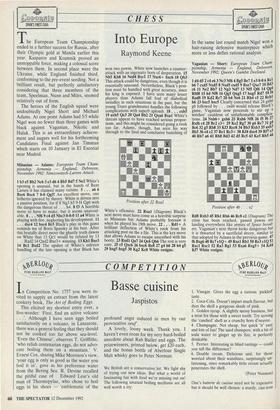COMPETITION
Basse cuisine
Jaspistos
In Competition No. 1757 you were in- vited to supply an extract from the latest cookery book, The Art of Boiling Eggs.
This elicited my shortest entry ever, a five-worder: 'First, find an active volcano . . .'. Although I have seen eggs boiled satisfactorily on a volcano, in Lanzarote, there was a general feeling that they should not be cooked too far above sea-level. 'Even the Chinese', observes T. Griffiths, 'who relish centenarian eggs, do not advo- cate boiling them on a mountain.' V. Ernest Cox, sharing Mike Morrison's view, 'your egg is only as good as the water you boil it in', gave as his preference water from fhe Bering Sea. R. Devine recalled the pitiful case of Edward Lear's old man of Thermopylae, who chose to boil eggs in his shoes — 'emblematic of the profound angst induced in men by our provocative oeuf.
A lovely, loony week. Thank you. I haven't even room for my very hard-boiled anecdote about Rab Butler and eggs. The prizewinners, printed below, get £20 each, and the bonus bottle of Aberlour Single Malt whisky goes to Peter Norman.
We British are a conservative lot. We fight shy of trying out new ideas. But what a world of fascinating fun with food we're missing out on! The following unusual boiling mediums are all well worth a try: 1. Vinegar. Gives the egg a curious `pickled' taste.
2. Coca-Cola. Doesn't impart much flavour, but dyes the shell a gorgeous shade of pink. 3. Golden syrup. A slightly messy business, but a treat for those with a sweet tooth. Try serving the `candied' shell as a crunchy hors d'oeuvre.
4. Champagne. Not cheap. but quick 'n' easy and lots of fun! The used champers, with a bit of soda water to ginger up its fizz, is perfectly drinkable.
5. Perrier. Interesting in blind tastings — could you tell the difference?
6. Double cream. Delicious and, for those worried about their waistlines, surprisingly un- fattening, since remarkably little cream actually penetrates the shell.
(Peter Norman)
One's batterie de cuisine need not be expensive but it should be well chosen: a sturdy, cast-iron pan with sides thick enough to provide an even, enveloping heat to the full height of the water; a set of Korean bamboo egg cradles in which the eggs may be lowered vertically into the pan and prevented from touching metal; a fine-grain egg-timer, preferably one with a stoppered end so that sand may be added or removed according to one's personal timing requirements; and last, but chiefest, a plentiful supply of Buxton spa water. It cannot be too often reiterated that eggs are, in effect, porous: if boiled in chlorinated tap water it is of chlorine that they will — faintly but undoubtedly — taste.
These items are all obtainable by post from Ova To You at 221B South Moulton Street, London.
(W. J. Webster) It is simply not the case any more that any old egg will do. Our parents and grandparents may have put up with the dubious products of the local farmyard or the chicken-run in the wartime back-garden, but we should know better. I myself have a distinct preference for eggs produced on the western slopes of the Andes, the hens responsible for them having been encouraged, Cortes-like, by a daily prospect of the Pacific. I have converted many friends to the special flavour of eggs with this particular provenance. I do, however, have to concede that running them a close second are eggs which come from the hills behind Amalfi. Enrico Albani, whose farm I prefer to the others, insists that it is his practice of singing to the hens which makes the difference. 'It must be sing with the human voice', he likes to say, 'not the recording. The recording only lead to addle.'
(Fergus Porter) As the water itself is not to be consumed, it may be drawn direct from the cold tap. You will need a sufficient amount to cover the egg, which is presumed to remain in a horizontal position at the bottom of the saucepan during cooking.
The desirable water depth is one centimetre above the diameter of the egg measured at its widest point. To obtain an accurate reading of this, place the egg lengthways between two flat-sided objects — a pair of book-ends would be ideal — which should then be gently pressed against the sides of the egg, taking care not to damage the shell (see diagram on facing page). Remove the egg and measure the distance between your chosen objects with the aid of a reliable ruler. At this stage, however, the calculations are complicated by the displace- ment factor . . .
(Suzan Lindsay Randle)
Have the head scullery maid place your nid de poulet over a pan of boiling Perrier (substitute claret if the eggs are for dinner). The garden lad should bring in a vigorously plump hen and place her in the metal nid, whereupon the shock of rising steam should encourage the, by now, startled hen to release the freshest possible egg — possibly two — into the water. The bird may now be returned to the hen-house as timing of the cooking process begins. Sand clocks, unless from Asprey's, are notoriously unreliable. We strongly recommend a stopwatch. (Chart 68 on page 163 gives recommended cooking times according to the altitude at which you are working.)
Meanwhile, instruct the cook to begin grating the Siberian rock salt sent down from Fortnum's last . . .
(Graeme Livingstone-Wallace)
No. 1760: Patchwork
You are invited to compose a poem (max- imum 12 lines) in which the lines are all taken from different poems by well-known poets. (Please indicate the sources.) En- tries to 'Competition No. 1760' by Wednes- day, 23 December.



































































 Previous page
Previous page